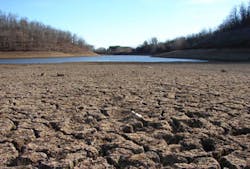Dealing with Drought: Making Tough (and Smart) Choices for Overcoming Water Scarcity
By Lori Anne Dolqueist
California is currently facing one of the worst droughts on record. These conditions developed because of record dry conditions throughout the state and a prolonged period of below-average rainfall in the Southwest. Likewise, the majority of California is under extreme or exceptional drought conditions, which are characterized by widespread water shortages, major crop and pasture losses, and substantial shortages of well and reservoir water, which can lead to water emergencies. A representative of the U.S. Department of Agriculture (USDA) recently stated that at the current usage rate, California has less than two years of water remaining.
California is not alone. More than 60 percent of the Western United States is in some form of drought. Large sections of Texas are experiencing exceptional or extreme drought. Continued dry, dusty and windy conditions in the Great Plains have sparked talk of a "New Dust Bowl." Even the historically wetter states in the Southeast have experienced droughts in recent years. These prolonged, dry conditions severely strain water supplies for all users.
The financial impact of drought will be in the billions. The agricultural industry will be one of the hardest hit since droughts have a substantial impact on livestock and crops, which will in turn affect job rates and food costs. Manufacturing, tourism and transportation will also feel the pain of water shortages. In the West, drought conditions have fueled damaging and deadly wildfires, leading to the loss of thousands of homes and businesses.
What differentiates the current water crisis from droughts of decades past is that many of the easiest steps have already been taken. The water efficiency of fixtures such as showerheads, toilets and washing machines has improved by leaps and bounds over the last several years. Community education programs that began as early as elementary school have increased awareness of water conservation. There is also a growing movement toward water-wise landscaping with native and drought-resistant plants, using recycled or recaptured water.
Unfortunately, these steps, while important, are not enough. It will take more than remembering to turn off the faucet while brushing your teeth, for example, to solve the current and predicted water shortages. Short-term solutions, such as temporary restrictions and rationing, are no longer sufficient. Agriculture uses must be given an unsentimental analysis. However, while it is important to continue to work to decrease water usage -- and that every effort must be made to bring water demand into line with the reality of constrained water supplies -- now is the time for a serious conversation about investment in water projects.
One of the first, and most basic, tools of water management is water meters. A surprising number of communities across the country provide water service to customers at a fixed flat rate, regardless of usage. Although it may seem like an obvious step, opposition to water meters remains strong in some areas. Part of it may be cultural, as long-standing residents accustomed to expansive green lawns and lush gardens may view unlimited water as a birthright. Others may be concerned by the cost of installing meters, particularly in areas already feeling the economic pinch. In other areas, where "smart" (electronic) water meters are proposed, the opposition is similar to the fight against smart meters used by electric companies, with opponents complaining of privacy issues and health problems. (Federal regulators have stated that the wireless technology in smart meters, which is similar to that used in cellphones, is safe.)
Even in drought-stricken California, more than 255,000 homeowners and businesses across the state are unmetered. These customers pay the same rate regardless of how much water they use. To compound the problem, water providers and regulators cannot track how much water these customers are using (or wasting). Numerous studies document the connection between meters and reduced water usage. Communities must be able to measure all water consumption to encourage efficient use of water and allow for proper management of constrained water resources. Without metered water connections, even the simplest steps to address water shortages are impossible.
Drought has also increased the popularity of recycled or reclaimed water projects. Using recycled water for non-potable uses saves potable water for drinking. In times of water scarcity, it is difficult to justify using potable water for municipal landscaping, outdoor irrigation or maintenance of large green spaces, such as golf courses. While in the past the concept of reuse was met with public distaste, it has gained increasing acceptance in recent years. Disposing of wastewater used to be a headache; now, if managed correctly, it can be an opportunity to augment or stabilize local water supply. What was once considered mere waste is now a valuable commodity as communities scramble to maximize the efficiency of their water use.
Increased investment in water storage may also help ameliorate the effects of drought. Water storage allows communities to prepare for drought by capturing and storing water in wet years in order to maintain a reliable system during the dry cycles. Dams, which have fallen out of favor in recent years, create reservoirs that can be used for water storage. Although environmental concerns can make it difficult to construct a new dam today, the size of existing dams could be increased to allow for additional storage capacity. These types of projects are usually very expensive however, and regulators and legislators must determine whether this is the best use of funds or whether alternative water storage options might provide "more bang for the buck."
In many instances, storing water underground is significantly more efficient than using surface reservoirs for storage. Underground water storage minimizes evaporation, which is a leading cause of water loss, especially in arid and semi-arid areas. Underground water storage involves refilling aquifers with surface water, storing the water and then pumping it back to the surface for processing and use.
The aquifers can be refilled (often using reclaimed water) either by directly injecting water through wells or by filling recharge basins, which allows water to slowly percolate downwards. Storing water underground avoids flooding land aboveground, as well as the costly litigation commonly associated with such efforts. However, not every aquifer is suited for underground storage. It is important, therefore, to undertake the proper analysis to avoid investing in a faulty underground storage project, and with a well-chosen project, storing surface water underground now can improve water security for the future.Conservation, recycling and storage help increase efficient use of existing water, but desalination is one of the few technologies that creates a new potable water supply. Desalination is the process by which salt and other minerals are removed from seawater to produce fresh water for consumption or irrigation. Energy costs can make desalination more expensive than fresh water from rivers or groundwater, or even recycled water, but where those sources are limited, desalination becomes an increasingly viable choice. Desalination is used extensively in the arid countries of the Middle East and is becoming increasingly common in drought-ridden Australia, but it was relatively rare in the U.S. until recently. Construction began last year on a desalination plant in Carlsbad, Calif., that is expected to produce 50 million gallons of water per day. Once completed, it will be the largest desalination facility in the Western Hemisphere.
If drought conditions continue as expected, communities that once dismissed desalination as too expensive may realize that it is a worthwhile investment when compared to the dire economic impacts of long-term water shortages. Most beneficial is the fact that, since it is not dependent on the vagaries of melting snowpack or rainfall, desalination is "drought-proof."
As extreme or exceptional drought conditions become the new baseline in many areas, now is the time to turn to new technologies or reconsider old ones. Water projects are rarely cheap -- these are multimillion-dollar, or even billion-dollar, projects. If multi-year droughts become the norm, however, the communities that survive (and thrive) will be the ones making smart choices about water use and investment right now.
About the Author: Lori Anne Dolqueist is a partner in the Energy, Environment & Natural Resources practice of law firm Manatt, Phelps & Phillips, and is based in the San Francisco office. She focuses her practice on water regulatory matters and regularly represents major water companies and smaller water utilities in various aspects of state and federal regulation. She can be reached at (415) 291-7452 or [email protected].


